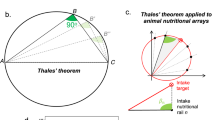Abstract
The linear programming model of optimal diet for herbivores has been criticized for being biologically unrealistic, for being too successful given statistical realities, and for being circular. I try to clarify the issue of circularity. Circularity arises if constraint lines are estimated from average values for governing parameters, when the assumed constraints are not effective. This may occur (1) under benign season conditions when consumers do not maximize their food intake, because of costs associated with food processing and storage, or (2) when an unidentified constraint limits intake. To evaluate hypotheses about the factors controlling diet composition, it must be shown that (1) consumers respond appropriately to variation in the parameters controlling constraint settings, and (2) the assumed constraints are close to their maximum (or minimum) settings.
Similar content being viewed by others
References
Belovsky GE (1978) Diet optimization in a generalist herbivore: the moose. Theor Popul Biol 14:105–134
Belovsky GE (1981) Optimal activity times and habitat choice of moose. Oecologia 48:22–30
Belovsky GE (1984) Herbivore optimal foraging: a comparative test of three models. Am Nat 124:97–115
Belovsky GE (1986) Optimal foraging and community structure: implications for a guild of generalist grassland herbivores. Oecologia 70:35–52
Belovsky GE (1987) An optimal foraging model for wild herbivores. In: Rose M (ed) Herbivore nutrition research: Proceedings of the second international symposium on the nutrition of herbivores (Occasional publication). Australian Society of Animal Production, Brisbane, pp 227–228
Belovsky GE (1990) A reply to Hobbs. In: Hughes RN (ed) Behavioral mechanisms of food selection (NATO ASI series, vol G20). Springer, Berlin Heidelberg New York, pp 415–422
Belovsky GE (1994) How good must models and data be in ecology? Oecologia 100:475–480
Belovsky GE, Schmitz OJ (1993) Owen-Smith's evaluation of herbivore foraging models: what is constraining? Evol Ecol 7:525–529
Belovsky GE, Schmitz OJ (1994) Plant defenses and optimal foraging by mammalian herbivores. J Mammal 75:816–832
Hobbs NT (1990) Diet selection by generalist herbivores: a test of the linear programming model. In: Hughes RN (ed) Behavioral mechanisms of food selection (NATO ASI series, vol G20). Springer, Berlin Heidelberg New York, pp 395–413
Huggard DJ (1994) A linear programming model of herbivore foraging: imprecise, yet successful? Oecologia 100:470–474
Milne JA, Macrae JC, Spence AM, Wilson S (1978) A comparison of the voluntary intake and digestion of a range of forages at different times of the year by the sheep and red deer. Br J Nutr 40:347–357
Owen-Smith N (1993) Evaluating optimal diet models for an African browsing ruminant, the kudu: how constraining are the assumed constraints? Evol Ecol 7:499–524
Owen-Smith N (1994) Foraging responses of kudus to seasonal changes in food resources: elasticity in constraints. Ecology 75:1050–1062
Owen-Smith N, Novellie P, (1982) What should a clever ungulate eat? Am Nat 119:151–178
Schoener T (1971) Theory of feeding strategies. Annu Rev Ecol Syst 2:369–404
Tolkamp BJ, Ketelaars JJMH (1992) Towards a new theory of feed intake regulation in ruminants. 2. Costs and benefits of feed consumption: an optimization approach. Livestock Prod Sci 30:297–317
Verlinden C, Wiley RH (1989) The constraints of digestive rate: an alternative model of diet selection. Evol Ecol 3:264–273
Author information
Authors and Affiliations
Rights and permissions
About this article
Cite this article
Owen-Smith, N. Circularity in linear programming models of optimal diet. Oecologia 108, 259–261 (1996). https://doi.org/10.1007/BF00334649
Received:
Accepted:
Issue Date:
DOI: https://doi.org/10.1007/BF00334649




